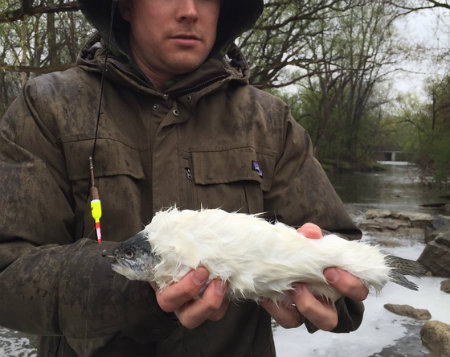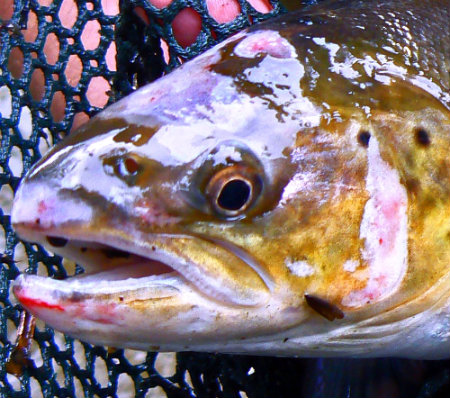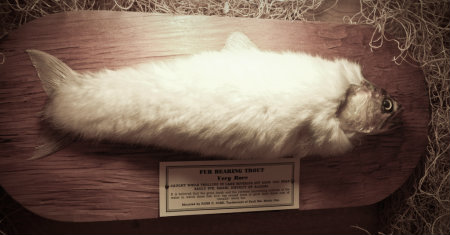

Exploring The Myth Of The Furry Trout: Reality Vs. Fiction
On May 5, 2015, an intriguing photograph surfaced online, claiming to show a fisherman in Wisconsin holding a rare furry trout. This image quickly captured the imagination of many, sparking curiosity and debate across various platforms. But what lies behind this captivating picture? In this article, we will unveil the truth about the so-called furry trout and explore the fascinating myths that have surrounded it.
As the photograph gained traction, it was picked up by several websites, including Unexplained Mysteries and Cult of Weird. These platforms stirred discussions about the legitimacy of such a species, leading many to wonder if there is any truth behind the concept of a furry trout. The claim was based on a story from a local Wisconsin carpenter, George Weber, who described his unexpected catch during a fishing trip on the Menomonee River.
George's account notes that wildlife officials explained his catch as a "rare fur-bearing trout" linked to a condition known as Saprolegnia, or cotton mold. This situation led to the spread of legends that such trout evolved to survive the cold waters of the Great Lakes. However, while these tales are entertaining, they raise a significant question: does a real furry trout exist, or is it merely a figment of folklore? Let's dive deeper into the history and the biological truths surrounding this fascinating fish tale.
Understanding the Claims Around the Furry Trout
The claims surrounding the furry trout originate from various anecdotes and urban legends, often suggesting that this species is unique to cold waters. Many enthusiasts refer to it as a "furry fish," "beaver trout," or even jokingly as a "sabled salmon." These names reflect the whimsical nature of the stories but also highlight the strong cultural narratives that have developed over time.
One of the most notable tales comes from Mr. J.H. Hicken, who shared his encounter with a furry fish in a 1929 issue of Montana Wildlife. In his colorful narrative, Hicken claimed to have caught a fish so cold that it "exploded" upon being removed from the water, leaving behind a beautiful coat of fur. This story has since been cited as an example of the mythical nature of the furry trout. However, the reality is that such creatures do not exist in the realm of scientific classification.
Scientific examination reveals that while molds like Saprolegnia can affect fish, leading to a furred appearance, they do not create the fluffy, fur-like coats described in legends. Instead, these molds typically appear in patches and are linked to the health of the fish, rather than serving as a protective adaptation.
The Role of Saprolegnia in Fish Health
Saprolegnia is a water mold that affects fish populations, especially those in distress. It thrives in environments where fish are weakened by stress or illness. When fish become infected, they can develop a fuzzy appearance due to the growth of this mold. Unlike the legendary furry trout, this condition is not a sign of a new species but rather an indicator of compromised health.
Although Saprolegnia does create visual effects that could resemble fur, it is essential to differentiate between these biological phenomena and the mythical narratives surrounding a furry trout. This distinction helps clarify misconceptions and offers better understanding of fish health and disease management.
Fiction vs. Reality: The Furry Trout Hoax
Despite the captivating tales of furry trout, the reality remains that no verified species exists under this name. Many of the stories are often humor-laden and reflect a rich tradition of storytelling rather than scientific fact. For example, one popular myth suggests that the furry trout originated from a hair tonic spill in the Arkansas River, while another theory claims it evolved to survive Alaska's frigid waters.
These tales, while entertaining, serve to illustrate the human tendency to weave narratives around anomalies in nature. They remind us of the inherent creativity in folklore and the need for scientific inquiry to separate fact from fiction. As we dissect these claims, we uncover the beauty of storytelling intertwined with the quest for truth.
In Summary: The Cultural Impact of the Furry Trout Legend
The story of the furry trout is a testament to the power of folklore in shaping our understanding of nature. While the furry trout itself may not exist, the discussions and debates surrounding it reflect our curiosity and desire to explore the unknown. As we continue to share these captivating tales, we foster a culture that appreciates both the whimsical and the scientific.
In conclusion, while the furry trout may be a product of our imaginations, it serves as a reminder of the rich tapestry of stories that shape our worldview. Whether as a cautionary tale about believing everything we see online or as a means of celebrating the creativity of human storytelling, the furry trout will continue to capture our interest for years to come.
So the next time you come across a peculiar fish story, take a moment to consider the blend of reality and fiction that it may represent. And who knows? Perhaps your next fishing expedition will yield a tale of your own!




Chevy Chase's Musical Roots: The Truth Behind His Time With Steely Dan
A Colorful Insight Into Pluto: The Dwarf Planet In May 2024
Unraveling The Truth: William Shatner's Death Hoax Exposed
